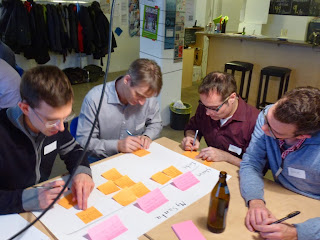This interview is translated from german. You can find the original version on Sven's blog.
Some weeks ago,
Sven Schäfer started to estimate business value with his team. They are using the regular planning poker cards to put a value on the story cards indicating how much the customer will profit from this story. I asked Sven to answer me some questions on how this is helpful for them:
You are now estimating business value in your team for some weeks. How did you get to the idea of estimating value in the team?
Sven: Business value - or the answer to why I am doing something - is something that is not discussed very frequently within our team. It is not an essential part of our requirements, too. But deep inside myself I do feel the need to know why I am doing things. I want to do something useful, at last. And I want to know this value is represented adequately somewhere. I do not want to believe only that something is useful, I want to see it somehow. Estimating the value is one option to make this visible for me.
What benefit do you see in estimating business value in your team?
Sven: Most important is the fact, that we are now talking about it frequently. That is, I am talking to other colleagues about what is in for the customer with a certain topic and what the topic contains. I do often not understand, why certain people are doing things, the way they do. I believe, that the discussion helps me to understand that. Speaking about the "why" just helps to understand other people better.
What exactly does "business value" mean to you?
Sven: First of all, I am thinking about money. If I am working for a company, then value always means, that a little more money comes out of an action than you put into it. That is value creation.
What do you do, if your customer does not understand how you estimated the value of a story?
Sven: If the customer tells us, that an estimate is not correct, she will probably have a good reason for that. She will be encouraged to inform us about the reason and give us a better estimate. We will then use this better estimate. Our estimation is only a first shot. If the customer tells us something better or more correct, then we are glad to learn.
Do you observe any positive or negative effects on the team from this value estimation?
Sven: I cannot say this from the perspectives of my team mates. For me personally it is helpful, because I do understand others in the team much better now.
The topic was mentioned positively twice in your teams retrospectives, already. So it seems, you are not the only person, to like this estimation.
Sven: I believe, that it is a big help for our product owner when he tries to prioritize the backlog. I think it is much easier for him, now that he has concrete estimates of the business value.
So the estimation of value seems to work well and to be helpful for your team. What do you think, whould be the next step for your team to advance a little?
Sven: We will definitely have to try to make this estimates more transparent to outsiders. Our customer must realize, that we are doing and working with value estimates and we will have to end up in a discussion with our customer. This will probably be a little bit unconvenient at first, but that is probably necessary to get talking.
Do you see a value for your customer in your team internal value estimation?
Sven: Of course, our costomer has not only one view about the importance and value of specific requirements, too. Every customer team has its own problems and priorities and they somehow have to decide on what is the most important thing for all of them and the whole company. Our value estimation and the discussion that is linked to it, could be a good foundation for the customer to be able to prioritize requirements better.
One last question: What do you think would be a huge step forward for your team?
Sven: I think, it would be exactly this discussion about business value with our customers.
Great! Thank you very much for this interview.























